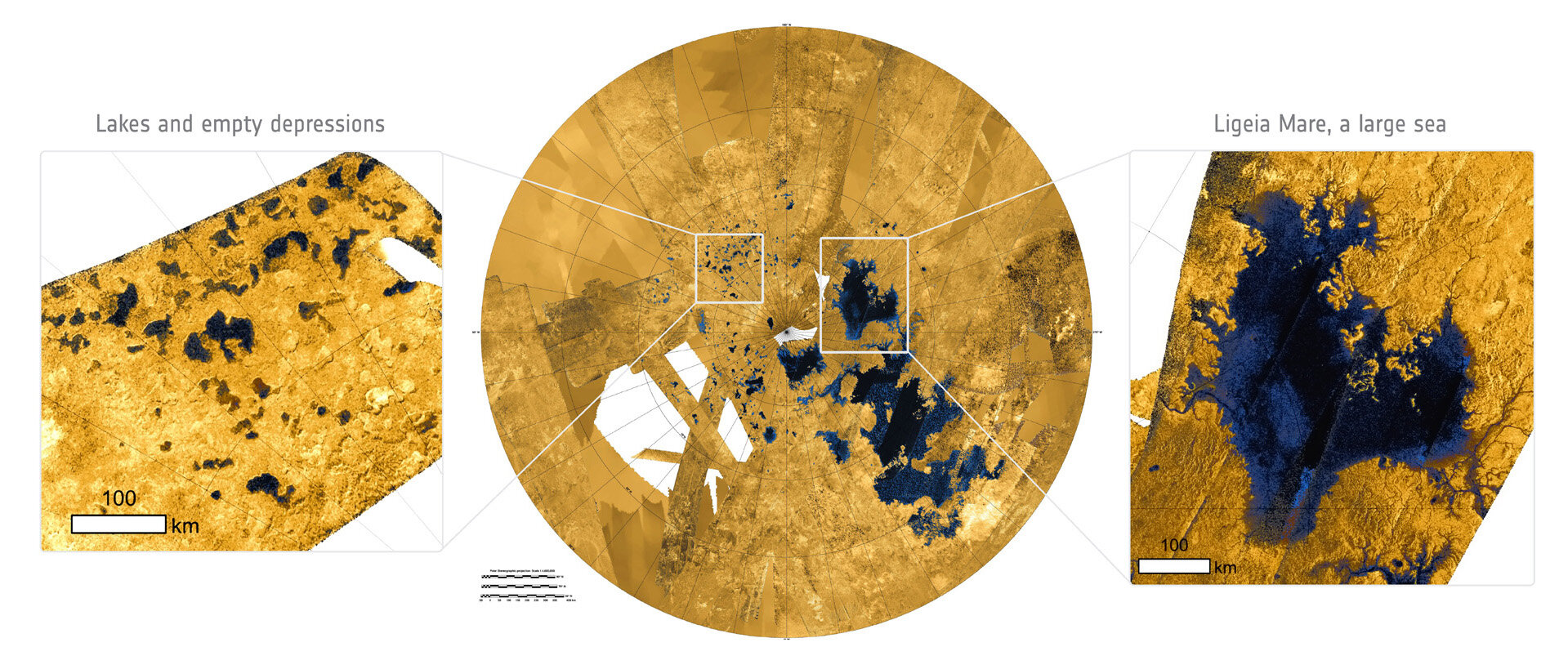In a recent study published in Geophysical Research Letters, scientists have revisited the enigma of Titan’s “magic islands,” previously thought to be either phantom islands caused by waves or real islands comprised of suspended solids, floating solids, or bubbles of nitrogen gas. This fresh perspective challenges prior notions, suggesting that these elusive phenomena might be floating chunks of porous, frozen organic solids rather than gas bubbles, as previously hypothesized.
Titan, Saturn’s largest moon, boasts a hazy orange atmosphere that is 50% thicker than Earth’s, teeming with methane and other carbon-based molecules. Its unique surface features dark dunes of organic material and vast seas of liquid methane and ethane. Intriguingly, radar imagery has captured fleeting bright spots on the surfaces of these seas, referred to as “magic islands,” which persist for varying durations, ranging from a few hours to several weeks.

The Cassini-Huygens mission first detected these mysterious phenomena in 2014, sparking scientific curiosity and prompting numerous investigations into their origin. The initial theories proposed that they could be manifestations of waves or tangible islands formed by suspended or floating solids. Xinting Yu, a planetary scientist and the lead author of the latest study, embarked on a more detailed examination of the interplay between Titan’s atmosphere, liquid lakes, and the solid materials deposited on its surface to decipher the underlying cause of these transient features.
Yu’s exploration delves into the possibility that the “magic islands” are, in fact, organics floating on Titan’s seas, akin to pumice floating on water on Earth before eventually submerging. This new perspective adds a layer of complexity to our understanding of Titan’s dynamic environment, shedding light on the fascinating interplay between the moon’s atmospheric conditions and the materials adorning its surface. As scientists continue to unravel the mysteries of Titan, each revelation brings us closer to comprehending the intricacies of this unique celestial body within our solar system.
The strange realm of organics
Within Titan’s densely populated upper atmosphere, an array of diverse organic molecules drift, forming clusters that can congeal, freeze, and descend onto the moon’s surface. This includes the eerily smooth rivers and lakes of liquid methane and ethane, where the undulating waves are merely a few millimeters in height.

The intrigue surrounding the fate of these organic clumps upon reaching Titan’s hydrocarbon lakes captivated Xinting Yu and her research team. One pivotal question lingered: would these organic particles sink or float on the liquid surfaces?
Addressing this query, the team initially delved into the possibility of Titan’s organic solids dissolving upon contact with the moon’s methane lakes. However, given that these lakes are already saturated with organic particles, the researchers concluded that the falling solids would not undergo dissolution upon reaching the liquid.
“For us to see the magic islands, they can’t just float for a second and then sink,” explained Yu. “They have to float for some time, but not for forever, either.”
The predominant components of Titan’s lakes and seas are methane and ethane, both characterized by low surface tension. This low surface tension poses a challenge for solids to remain afloat. Advanced models employed by the research team suggested that the majority of frozen solids were too dense, and the surface tension was insufficient to give rise to Titan’s enigmatic “magic islands” unless the organic clumps exhibited a porous structure akin to Swiss cheese.
This revelation sheds light on the delicate balance between the density of the frozen solids and the surface tension of Titan’s liquid lakes, offering a nuanced understanding of the conditions necessary for the formation and persistence of the captivating phenomena observed on this distant moon.
In a fascinating exploration of Titan’s mysteries, researchers led by Xinting Yu have unveiled intriguing insights into the behavior of icy clumps on the moon’s surface. By employing sophisticated modeling techniques, the team discovered that if these icy clumps were sufficiently large and possessed the right combination of holes and narrow tubes, liquid methane could infiltrate slowly enough to allow the clumps to persist at the surface.
The modeling conducted by Yu proposed that individual clumps might be too diminutive to remain buoyant on their own. However, an intriguing possibility emerged—when these smaller clumps amassed near the shores, larger pieces could break off and float away, analogous to the process of glaciers calving on Earth. This phenomenon, characterized by a substantial size and optimal porosity, presents a plausible explanation for the enigmatic “magic islands” observed on Titan’s lakes and seas.
Beyond unraveling the mystery of the magic islands, the research also shed light on another perplexity surrounding Titan’s liquid bodies. A thin layer of frozen solids coating the seas and lakes, possibly resulting from the same process, could elucidate the unusual smoothness observed on the surfaces of these expansive bodies. Consequently, the findings from this study not only contribute to deciphering the origin of the magic islands but also offer a potential explanation for the remarkable smoothness characterizing Titan’s liquid expanses. This multifaceted revelation marks a significant stride in our comprehension of the complex interactions shaping the unique landscape of Saturn’s largest moon.
Resources
- ONLINE NEWS Lester, L. & American Geophysical Union. (2024, January 5). Titan’s “magic islands” are likely to be honeycombed hydrocarbon icebergs, finds study. Phys.org. [Phys.org]
- JOURNAL Yu, X., Yu, Y., Garver, J., Zhang, X., & McGuiggan, P. (2024). The fate of simple organics on Titan’s Surface: A theoretical perspective. Geophysical Research Letters, 51(1). [Geophysical Research Letters]
Cite this page:
APA 7: TWs Editor. (2024, January 8). Research Indicates Titan’s “Enigmatic Isles” Could Be Honeycombed Hydrocarbon Ice Structures. PerEXP Teamworks. [News Link]












